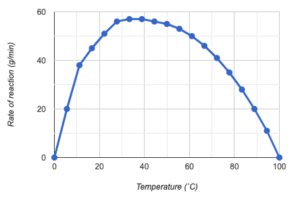What are Enzymes and what do they do?
Enzyme Action, Activity and Nutrition
Good Luck!
Quiz Summary
0 of 18 Questions completed
Questions:
Information
You have already completed the quiz before. Hence you can not start it again.
Quiz is loading…
You must sign in or sign up to start the quiz.
You must first complete the following:
Results
Results
0 of 18 Questions answered correctly
Your time:
Time has elapsed
You have reached 0 of 0 point(s), (0)
Earned Point(s): 0 of 0, (0)
0 Essay(s) Pending (Possible Point(s): 0)
| Average score |
|
| Your score |
|
Categories
- Not categorized 0%
- 1
- 2
- 3
- 4
- 5
- 6
- 7
- 8
- 9
- 10
- 11
- 12
- 13
- 14
- 15
- 16
- 17
- 18
- Current
- Review
- Answered
- Correct
- Incorrect
-
Question 1 of 18
1. Question
Drag and drop to match the term with the description
Sort elements
- Enzyme specificity
- Enzyme activity
- Active site
- Substrates
- Enzymes catalyse unique reactions
- Efficiency of catalysis
- Where substrate binds and reaction takes place
- Molecules that change in a reaction
CorrectIncorrect -
Question 2 of 18
2. Question
What is the Lock and Key Model of enzyme action?
CorrectIncorrect -
Question 3 of 18
3. Question
What is the Induced Fit Model of enzyme action?
CorrectIncorrect -
Question 4 of 18
4. Question
Why is catalysis by enzymes important for life processes?
CorrectIncorrect -
Question 5 of 18
5. Question
Why is the rate of an enzyme-controlled reaction highest at an optimum pH?
CorrectIncorrect -
Question 6 of 18
6. Question
Why does the rate of an enzyme-controlled reaction go down as temperature increases past the optimum level?
CorrectIncorrect -
Question 7 of 18
7. Question
Why is the rate of an enzyme-controlled reaction lower at lower temperatures?
CorrectIncorrect -
Question 8 of 18
8. Question
[question number = 07.1] Why does the rate of an enzyme-controlled reaction increase with greater substrate concentration?
CorrectIncorrect -
Question 9 of 18
9. Question
Why does the rate of an enzyme-controlled reaction plateau at a certain substrate concentration?
CorrectIncorrect -
Question 10 of 18
10. Question
Drag and drop to match the monomers with their polymers
Sort elements
- Fats/lipids
- Proteins
- Carbohydrates
- DNA
- Fatty acids/glycerol
- Amino acids
- Glucose
- Nucleotides
CorrectIncorrect -
Question 11 of 18
11. Question
Drag and drop to match the enzymes with the polymer they break down
Sort elements
- Amylase
- Lipases
- Carbohydrases
- Proteases
- Starch
- Lipids
- Carbohydrates
- Proteins
CorrectIncorrect -
Question 12 of 18
12. Question
Carbohydrases (including amylase), proteases and lipases are all produced in the same organ. What is this organ called?
CorrectIncorrect -
Question 13 of 18
13. Question
Use some of the following words to fill in the blanks.
Important, polymers, active, inactive, special, bonds, monomers
-
Complete the statements about enzyme action:
- Enzymes interact with substrates to either break down large molecules known as into smaller ones known as .
- Alternatively, they put small molecules together into larger ones.
- This happens when the site of the enzyme connects with the substrate.
- When making larger molecules from smaller ones, the enzyme holds the molecules together in the correct position while form.
CorrectIncorrect -
-
Question 14 of 18
14. Question
When the shape of an active site is changed, we say it has what?
CorrectIncorrect -
Question 15 of 18
15. Question
Carbohydrates, quadrats, catalysts, chemicals, proteins
-
Complete the sentence: Enzymes are that act as biological .
CorrectIncorrect -
-
Question 16 of 18
16. Question
An enzyme is used to break down starch into small sugars. The following graph shows how the rate of reaction changes over time. The y-axis represents the amount of starch digested. Fill in the blanks to show the correct rate of reaction at each temperature.

-
Enter your estimate into the blanks below. Use whole numbers and no decimals.
40˚C – g/min
60˚C – g/min
80˚C – g/min
CorrectIncorrect -
-
Question 17 of 18
17. Question
An experiment is conducted to measure the rate of reaction of the enzyme starch synthase. 720g of starch was synthesised in 120s. Calculate the rate of reaction in g/min.
-
g/min
CorrectIncorrect -
-
Question 18 of 18
18. Question
Enzymes are important for living organisms to survive. Fill in the blanks to explain why they are so important for the digestive system to function properly.
Use some of the following words:
Soluble, insoluble, solvent, solution
-
- The digestive system breaks down large polymers into smaller monomers.
- Once the materials we need to build our bodies and complete processes like respiration are , they can be absorbed into our blood through our intestines.
CorrectIncorrect -
Learn more about this topic on our page on Enzyme Action. Also, see Enzymes and Nutrition for information about how digestion involves enzymes.
Which exam board are you studying?

